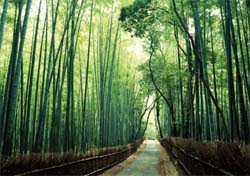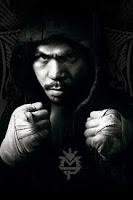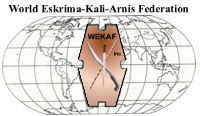Technical aspects
Ranges
Most systems recognize that the technical nature of combat changes drastically as the distance between opponents changes, and generally classify the ranges into at least three categories. Each range has its characteristic techniques and footwork. Of course, some systems place more emphasis on certain ranges than others, but almost all recognize that being able to work in and control any range is essential. The Balintawak style for example, uses long-, medium- and short-range fighting techniques, but focuses on the short-range.

In order to control the range, and for numerous other purposes, good footwork is essential. Most eskrima systems explain their footwork in terms of triangles: normally when moving in any direction two feet occupy two corners of the triangle and the step is to the third corner such that no leg crosses the other at any time. The shape and size of the triangle must be adapted to the particular situation. The style of footwork and the standing position vary greatly from school to school and from practitioner to practitioner. For a very traditional school, very conscious of battlefield necessities, stances will usually be very low, often with one knee on the ground, and footwork will be complex, involving many careful cross-steps to allow practitioners to cope with multiple opponents. The Villabrille and San Miguel styles are usually taught in this way. Systems that have been adapted to duels or sporting matches generally employ simpler footwork, focusing on a single opponent. North American schools tend to use much more upright stances, as this puts less stress on the legs, but there are some exceptions.
Strikes

Many Filipino systems focus on defending against and/or reacting to angles of attack rather than particular strikes. The theory behind this is that virtually all types of hand-to-hand attacks (barehanded or with a weapon) will hit or reach a combatant via these angles of attack and it is reasoned that it is more efficient to learn to defend against different angles of attack rather than learning to defend against particular styles, particular techniques or particular weapons. For instance, the technique for defending against an attack angle that comes overhead from the right is very similar whether the attacker uses barefists, a knife, a sword or a spear.
Older styles gave each angle a name, but more recent systems tend to simply number them. Many systems have twelve standard angles, though some have as few as 5, and others as many as 72. Although the exact angles, the order in which they are numbered (numerado), and the manner in which they're executed vary from system to system, most are based upon Filipino cosmology. These standard angles are used to describe exercises; to aid memorization, a standard series of strikes from these angles called an abecedario (Spanish for "alphabet") is often practiced. These are beginner strikes or the "ABC's" of eskrima.

Some angles of attack and some strikes have characteristic names.
San Miguel is a forehand strike with the right hand, moving from the striker's right shoulder toward their left hip. It is named after Saint Michael or the Archangel Michael, who is often depicted holding a sword at this angle. This is the most natural strike for most untrained people. It is commonly referred to as "angle #1," in systems where striking angles are numbered for training purposes, because it is presumed to be the most probable angle of attack.
Sinawali is the signature double-stick weaving movement associated with Arnis and Eskrima named after the woven coconut or palm leaves called sawali that comprise the walls of nipa hut dwellings. It is commonly seen in double-stick continuous attack-parry partner demonstrations.
Another signature technique is the Redonda which is a continuous circular downward-striking double-stick twirling technique.
A redondo (Spanish for "round") is a strike that whips in a circle to return to its point of origin. This is especially useful when using sticks rather than swords, such a strike allows extremely fast strikes but needs constant practice.
An abanico (Spanish for fan) or witik is a strike that is executed by flicking the wrist 180 degrees in a fan-shaped motion. This kind of strike can be very quick and arrive from unexpected angles.
Pilantik is a strike executed by whipping the stick around the wrist over the head in a motion similar to the abanico, but in alternating 360 degree strikes. It is most useful when fighters are in grappling range and cannot create enough space for normal strikes.
Hakbang (Filipino for "step") is a general term for footwork. For example, hakbang paiwas is pivoting footwork, while hakbang tatsulok is triangle stepping.
Puño (Spanish for "fist") is a strike delivered with the butt of the weapon. It usually targets a nerve point or other soft spot on the opponent but in skilled hands, the puño can be used to shatter bones.
It is to be noted that many of the Eskrima techniques have Spanish names because Spanish was the lingua franca spoken during colonial times among the natives who spoke over 170 different languages in the archipelago's 7,100+ islands.
Eskrima techniques are generally based on the assumption that both the student and their opponent are very highly trained and well prepared. For this reason, eskrima tends to favor extreme caution, always considering the possibility of a failed technique or an unexpected knife. On the other hand, the practitioner is assumed to be able to strike very precisely and quickly. The general principle is that an opponent's ability to attack should be destroyed rather than trying to hurt them to convince them to stop. Thus many strikes are aimed at the hands and arms, hoping to break the hand holding the weapon or cut the nerves or tendons controlling it (the concept of defanging the snake), but strikes to the eyes and legs are important. A popular mnemonic states that "stick seeks bone, blade seeks flesh".
Mano Mano
Mano Mano is the empty-hand component of Filipino martial arts, particularly eskrima. The term translates as "hands" or "hand to hand" and comes from the Spanish word mano (hand). It is known as suntukan or panununtukan in Luzon and pangamot in the Visayas. American colonists referred to it as "combat judo".
Mano mano includes kicking, punching, locking, throwing and dumog (grappling). Filipino martial artists regard the empty hands as another weapon and all the movements of mano mano are directly based on weapon techniques. In eskrima, weapons are seen as an extension of the body so training with weapons naturally leads to proficiency in bare-handed combat. For this reason, mano mano is generally taught in the higher levels of eskrima because advanced students are expected to be able to apply their experience with weapons to unarmed fighting.
Kicking

Pananadiyak, Pagtadiyak, Pananjakman, Sikaran, Pagsipa or Paninipa (all terms for "kicking" in various regions, dialects and styles) are components of eskrima which focuses on low-line kicks. Some claim that the particular system of Pananjakman is an art in and of itself but this separation was probably made for the purpose of marketing the art as a new system. Except for the distinct style of Sikaran from the Baras area of the province of Rizal, Pananjakman is never taught by itself in the Philippines, and this practice is only done in the West.
Pananadiyak can be regarded as the study of leg muscles and bones and how they are connected, with the goal of either inflicting pain or outright breaking or dislocating the bones. Most striking techniques involve applying pressure to bend the target areas in unnatural ways so as to injure or break them. Such pressure may be delivered in the form of a heel smash, a toe kick, a stomp, or a knee. Targets include the groin, thighs, knees, shins, ankles, feet and toes. The upper body is used only for defensive maneuvers, making pananadiyak ideal for when combatants are engaged in a clinch. When used effectively, the strikes can bring an opponent to the ground or otherwise end an altercation by making them too weak to stand.
Fundamental techniques include kicking or smashing the ankle to force it either towards or away from the opposite foot (severe supination or pronation, respectively), heel-stomping the top of the foot where it meets the lower leg so as to break or crush the numerous bones or otherwise disrupt the opponent's balance, and smashing the opponents knee from the side to break the knee (with severe supination and pronation as the desired result).
Drills

Several classes of exercises, such as sombrada, contrada, sinawali, hubud-lubud and sequidas, initially presented to the public as a set of organized drills by the Inosanto school, are expressly designed to allow partners to move quickly and experiment with variations while remaining safe. For example, in a sombrada drill taken from the Villabrille style, one partner feeds an attack, which the other counters, flowing into a counterattack, which is then countered, flowing into a counterattack, and so on. The hubud-lubud or hubad-lubad from Doce Pares is frequently used as a type of "generator" drill, where one is forced to act and think fast. Initially, students learn a specific series of attacks, counters, and counter-attacks. As they advance they can add minor variations, change the footwork, or switch to completely different attacks; eventually the exercise becomes almost completely free-form. Palakaw, from the Balintawak style, are un-choreographed and random defensive and offensive moves. Palakaw in Cebuano means a walk-through or rehearsing the different strike angles and defenses. It may be known as corridas or striking without any order or pattern. Disarms, take-downs, and other techniques usually break the flow of such a drill, but they are usually initiated from such a sequence of movements in order to force the student to adapt to a variety of situations. A common practice is to begin a drill with each student armed with two weapons; once the drill is flowing, if a student sees an opportunity to disarm their opponent, they will, but the drill will continue until both students are empty-handed. Some drills use only a single weapon per pair, and the partners take turns disarming each other. Seguidas drills, taken from the San Miguel system, are sets of hitting and movement patterns usually involving stick and dagger.
Rhythm, while an essential part of eskrima drills, is given more emphasis in the United States and Europe where a regular beat serves a guide for students to follow. To ensure the safety of the participants, most drills are done at a constant pace which is increased as the students progress. The rhythm, together with the southern Filipino attire of a vest and sashed pants, is commonly mistaken to be some sort of tradition when practicing eskrima in the Philippines – perhaps incorrectly derived from traditional rhythm-based dances or an attempt to add a sense of ethnicity. Eskrima is usually practiced in the Philippines without a rhythm, off-beat or out of rhythm. The diversity of Filipino martial arts means that there is no officially established standard uniform in eskrima.
The Live Hand
The live hand is the opposite hand of the practitioner that does not contain the main weapon. The heavy usage of the live hand is an important concept and distinguishing hallmark of Eskrima. Even (or especially) when empty, the live hand can be used as a companion weapon by Eskrima practitioners. As opposed to most weapon systems like fencing where the off-hand is hidden and not used to prevent it from being hit, Eskrima actively uses the live hand for trapping, locking, supporting weapon blocks, checking, disarming, striking and controlling the opponent.

The usage of the live hand is one of the most evident examples of how Eskrima's method of starting with weapons training leads to effective empty hand techniques. Because of Doble Baston (double weapons) or Espada y Daga (sword and parrying dagger) ambidextrous weapon muscle memory conditioning, Eskrima practitioners find it easy to use the off-hand actively once they transition from using it with a weapon to an empty hand.
Doble baston

Doble baston, and less frequently doble olisi, are common names for a group of techniques involving two sticks. The art is more commonly known around the world as Sinawali meaning "to weave". The term Sinawali is taken from a matting called sawali that is commonly used in the tribal Nipa Huts which is made up of woven pieces of palm leaf and used for both flooring and walls.
This technique requires the user to use both left and right weapons in an equal manner; many co-ordination drills are used to help the practitioner become more ambidextrous. It is the section of the art that is taught mainly at the intermediate levels and above and is considered one of the most important areas of learning in the art.
Sinawali
Sinawali refers to the activity of "weaving", as applied Eskrima with reference to a set of two-person, two-weapon exercises.

Sinawali exercises provide eskrima practitioners with basic skills and motions relevant to a mode of two-weapon blocking and response method called Doblete. Sinawali training is often introduced to novices in order to develop certain fundamental skills including: body positioning and distance relative to an opponent, rotation of the body and the proper turning radius, recognition of one’s center of gravity, eye–hand coordination, target perception and recognition, increased ambidexterity, recognition and performance of rhythmic structures for upper body movement, and muscular developments important to the art, especially, the wrist and forearm regions. It helps teach the novice eskrimador proper elbow positioning while swinging a weapon.
Cross-training
The Chinese and Malay communities of the Philippines have practiced eskrima together with kuntaw and silat for centuries, so much so that many North Americans mistakenly believe silat to have originated in the Philippines.
Some of the modern styles, particularly doce pares and modern arnis contain elements of Japanese martial arts such as judo and karate as some of the founders were blackbelters in these systems. Eskrima is complementary with aikido because of the rounded nature of the conditioning and body mechanics when twirling or swinging sticks.
In Western countries, it is common for eskrima to be practiced in conjunction with other martial arts, particularly wing chun, jeet kune do or silat. As a result, there is some confusion between styles, systems and lineage because some people cross-train without giving due credit to the founders or principles of their arts. For example, American Kenpo cross-training traces back to the interactions between Chinese, Japanese and Filipino immigrants in territorial/pre-statehood Hawaii, and to a lesser extent in other parts of the United States. Another one is the cross-training between eskrima and Wing Chun or JKD which dates back to Bruce Lee's close collaboration with Dan Inosanto (the weapons aspect of JKD comes primarily from eskrima and Bruce Lee considered it as the martial art which had the closest philosophy to JKD).
Proponents of such training say the arts are very similar in many aspects and complement each other well. It has become marketable to offer eskrima classes in other traditional Asian martial arts studios in America but some practitioners of other eskrima styles often dismiss these lessons as debased versions of original training methods.














































